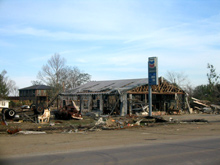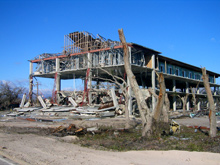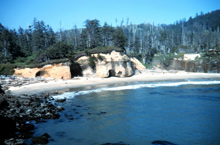Coastal Issues | Coastal Hazards
Coastal Hazards
"As the coasts become increasingly populated, more and more people are placed in harm's way. Thus far, science has not found effective ways to reduce most hazards. Therefore, citizens must look to strengthening communities. Building safer buildings and strengthening infrastructure are important steps, but it is the manner in which societies are built that largely determines disaster resilience. A vital part of effective disaster planning—whether for mitigation, preparation, response, or recovery—is an understanding of the people and institutions that make up each community, including their strengths and their weaknesses, as a basis for developing policies, programs, and practices to protect them. In the end, it is human decisions related to such matters as land use planning and community priorities that will build stronger, safer, and better communities"
— H. John Heinz III Center for Science, Economics and the Environment, 2002, "Human Links to Coastal Disasters."

Damage from Hurricane Katrina in Port Sulphur, Plaquemines Parish, LA. The eye of Katrina made landfall approximately 10 miles east of Port Sulphur (December 2005).
The U.S. coast confronts a wide range of natural hazards from hurricanes and severe storms to floods and landslides, earthquakes and tsunamis, shoreline erosion and land subsidence. All of these coastal hazards threaten both lives and property—a problem that becomes more pressing as the coastal population continues to rise. Although coastal counties comprise only 17 percent of the nation's land area, they are home to over half the U.S. population. In 2003, 153 million people lived along the coast, 33 million more then in 1980. The population was projected to grow by another 7 million by 2008.
Intensive development in the coastal zone not only places more people and property at risk to coastal hazards, but it also interferes with natural protections from severe hazard events. For instance, seawalls on a beach accelerate beach erosion and inhibit the beach's ability to absorb storm energy, thus exposing buildings to the full force of wind and waves. Development can also destroy wetlands which serve as important buffers again storm surge and flooding.
Hurricanes and Typhoons
The 2004 Atlantic hurricane season was one of the worst on record, with damages estimated at $25 billion. However, 2004 was quickly surpassed by the 2005 season, the most destructive on record. The 2005 season included 26 named storms, including 13 hurricanes in which seven were major (Category 3 or higher). Four major hurricanes made landfall in the U.S.
In late August, Hurricane Katrina formed over the Bahamas and crossed southern Florida as a Category 1 hurricane. The storm strengthened over the Gulf of Mexico and made its second landfall near Buras-Triumph, Louisiana on August 29 as an extremely large Category 3 storm. Hurricane Katrina became one of the worst storms on record with estimates of over 1,300 deaths from the affected states. Three weeks later, Hurricane Rita devastated parts of southwest Louisiana. Combined, Katrina (the costliest U.S. storm on record) and Rita caused an estimated $200 billion in damage, according to NOAA's National Hurricane Center. Katrina's effects will be felt for years to come as coastal communities struggle to rebuild their infrastructure and people displaced by the storm struggle to rebuild their lives.

Katrina's high winds and a storm surge exceeding 30 feet destroyed this beachfront structure in Pass Christian, MS. (December 2005).
Earthquakes and Tsunamis
Earthquakes and tsunamis are extremely dangerous natural hazards that threaten the coasts and inland waters of California, Oregon, Washington, Alaska, Hawaii, territories in the Pacific region, and Puerto Rico and the Virgin Islands in the Caribbean. In less than a day, tsunamis can travel from one side of the ocean to the other. However, tsunami waves can reach nearby shores within minutes of an earthquake. The 2004 Indian Ocean earthquake and tsunami increased awareness of the catastrophic nature of tsunamis. The earthquake triggered a series of lethal tsunamis on December 26 that killed approximately 275,000 people, displaced more than one million people, and caused billions of dollars of property damage.
Coastal Erosion and Subsidence
The less dramatic phenomena of erosion and subsidence are no less important. Erosion undermines waterfront homes, businesses, and public infrastructure, eventually making them uninhabitable or unusable. Coastal erosion in the United States is responsible for approximately $500 million per year in coastal property loss, including damage to structures and loss of land. To mitigate coastal erosion, the federal government spends an average of $150 million every year on beach nourishment and other shoreline erosion control measures. Despite these efforts, erosion over the next 60 years, according to a 2000 Heinz Center study, may claim one out of four houses within 500 feet of the U.S. shoreline, perhaps more with accelerated coastal erosion and property loss from the predicted sea level rise this century. Subsidence is the lowering of a portion of the earth's crust, which causes a loss of surface elevation due to the removal of subsurface support. Subsidence can be caused by both natural and human activities.
Subsidence due to groundwater removal is being experienced in Texas and Florida, with the resulting inundation and flooding threatening high-value land uses. In California, subsidence due to oil and gas removal has cost millions in damages and remedial costs.

Chronic bluff erosion can be a significant hazard in many coastal areas.
Floods
Flood damages in the United States continue to escalate. From the early 1900's to 2000, flood damages in the United States have increased six fold, approaching $6 billion annually. This occurred despite billions of dollars for structural flood control, and other structural and non-structural measures. However, development continues to intensify within flood prone and marginal areas. Over the years, floodplain mangers have become more aware of the benefits of protecting the natural functions of floodplains. Protecting floodplains not only protects property from flood losses but it also preserves natural ecosystems. This attitude is part of a broader movement toward using the criteria of "sustainability" in development, economic decision-making, and resource use.
For additional information contact Josh Lott.
